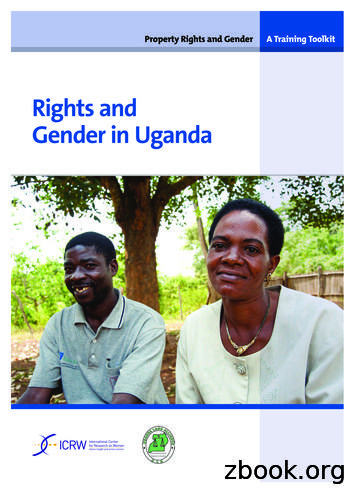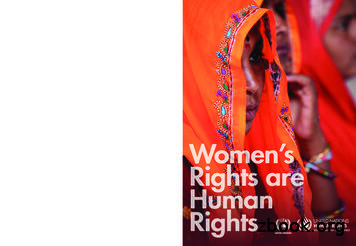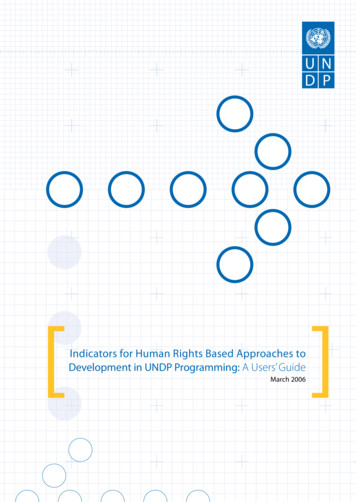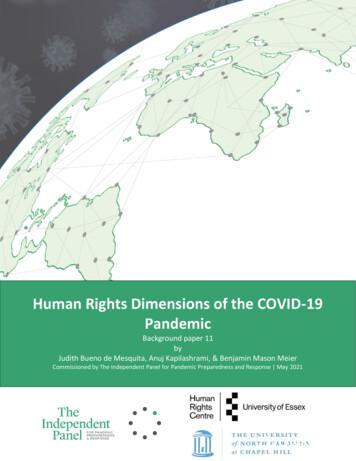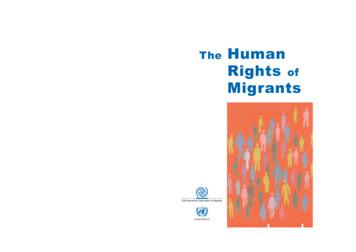Australia And Human Rights: An Overview (4th Edition)
Australia and Human Rights: An Overview (4th Edition)1
Table of ContentsForeword by the Minister for Foreign Affairs . 6About this Manual. 8CHAPTER 1 . 10The Nature of Human Rights . 10Historical context . 10Some parameters of contemporary human rights practice . 14First, second and third generation human rights . 14The universality and indivisibility of human rights . 15Human rights and national sovereignty . 16Responsibility to Protect . 16CHAPTER 2 . 19The International Legal Framework . 19What is international law? . 19The individual in international law . 19The sources of international law . 20Treaties . 20Customary international law . 26Enforcement . 27CHAPTER 3 . 30The Major International Human Rights Instruments . 30The Universal Declaration of Human Rights. 30The International Covenants . 32International Covenant on Economic, Social and Cultural Rights . 33International Covenant on Civil and Political Rights . 33First Optional Protocol to the International Covenant on Civil and Political Rights 36Second Optional Protocol to the International Covenant on Civil and PoliticalRights, aiming at the abolition of the death penalty . 36Convention on the Elimination of All Forms of Racial Discrimination . 36Convention on the Elimination of All Forms of Discrimination against Women . 38Convention against Torture and Other Cruel, Inhuman and Degrading Treatment orPunishment . 41Convention on the Rights of the Child . 432
Optional Protocol on the Sale of Children, Child Prostitution and Child Pornography. 45Optional Protocol on the Involvement of Children in Armed Conflict . 46International Convention on the Protection of the Rights of all Migrant Workers andMembers of their Family . 48Convention on the Rights of Persons with Disabilities . 49Convention for the Protection of all Persons from Enforced Disappearance . 52UN declarations and resolutions . 54CHAPTER 4 . 56The United Nations System and Human Rights . 56Charter-based bodies . 57The General Assembly. 57The Security Council . 58The Economic and Social Council . 60Human Rights Council . 61Membership and structure. 61Universal Periodic Review . 62Special Procedures . 63Complaints procedure . 64Other subsidiary bodies. 65Office of the High Commissioner for Human Rights . 65Treaty-based bodies . 66Human Rights Committee – International Covenant on Civil and Political Rights . 68Committee on Economic, Social and Cultural Rights – International Covenant onEconomic, Social and Cultural Rights . 69Committee on the Elimination of Racial Discrimination – Convention on theElimination of Racial Discrimination . 69Committee on the Elimination of Discrimination against Women – Convention onthe Elimination of all forms of Discrimination against Women . 70Committee against Torture – Convention against Torture and Other Cruel, Inhumanor Degrading Treatment or Punishment . 71Committee on the Rights of the Child – Convention on the Rights of the Child . 73Committee on Migrant Workers – International Convention on the Protection of AllMigrant Workers and Members of Their Families . 743
Committee on the Rights of Persons with Disabilities – Convention on the Rights ofPersons with Disabilities . 74Committee on Enforced Disappearances – International Convention for theProtection of All Persons from Enforced Disappearances . 75Treaty body reform . 76Other organisations within the United Nations system. 77United Nations Educational, Scientific and Cultural Organization . 77United Nations High Commissioner for Refugees . 77International Labour Organization . 78International Law Commission . 79Food and Agriculture Organization . 80World Health Organization . 80CHAPTER 5 . 81National Human Rights Institutions and Regional Approaches . 81National human rights institutions – an overview . 81National institutions and international cooperation . 81National institutions and regional cooperation . 82Asia Pacific Forum of National Human Rights Institutions . 83Australian Human Rights Commission . 84Independence from Government. 85Statutory role and functions . 85Complaint and conciliation functions . 86Other statutory functions. 86Regional approaches to the protection and promotion of human rights . 87Europe . 87Africa . 90The Americas . 91The Middle East . 92The Commonwealth . 93CHAPTER 6 . 95Human Rights in Practice – the Protection of Human Rights in Australia . 95How are human rights protected in Australia? . 95Existing institutionalised processes . 95Specialised human rights machinery . 984
Other protections . 99ANNEX ONE: Useful Resources . 1025
Foreword by the Minister for Foreign AffairsAustralia will step up its efforts to promote and protect humanrights around the world by serving as a member of the UnitedNations Human Rights Council, the world’s peak human rightsbody, for the 2018-2020 term.It is in Australia’s national interest to protect and promote humanrights, uphold the international rules based order and shape thework of the United Nations. As a founding member of the UnitedNations, and one of only eight nations involved in the drafting ofthe Universal Declaration on Human Rights, Australia was, andis, of the view that human rights deliver peace, security andprosperity to Australia and the world.Australia has a long history of working with other countries andsupporting civil society participation in the multilateral system inline with our values as a democratic state. Civil society is acritical link between international commitments to uphold humanrights and the lived experience of individuals.Australia will bring a pragmatic, principled approach to its termon the Human Rights Council. By providing an Indo-Pacificperspective we will ensure that the voices of our Pacificneighbours and other small states are heard.Our term on the Council will be guided by the five pillars whichunderpinned our campaign for election: gender equality; freedomof expression; good governance and strong democraticinstitutions; advancing the human rights of indigenous peoples;and strong national human rights institutions.Australia will also continue to promote the abolition of the deathpenalty worldwide, freedom of religion and belief, the rights ofpersons with a disability and the rights of LGBTI peoples.The Human Rights Manual provides information to the public onhuman rights issues and their contemporary legal framework. Italso assists government officials to gain a firm grounding inhuman rights issues as they seek to protect and advance humanrights around the world.Julie BishopDecember 20176
7
About this ManualThis fourth edition of the Human Rights Manual has been prepared by the Department ofForeign Affairs and Trade’s (DFAT) Human Rights Branch to foster a deeperunderstanding of human rights among officers of the department, especially those whohandle human rights as part of their work responsibilities. It is also intended to providethe public an explanation of how human rights policy is pursued.The manual is not intended to be an exhaustive examination of the history, principles orcurrent status of human rights issues. There are numerous texts and journals devoted tothese issues that can be consulted for more detailed examination of various aspects ofhuman rights. Instead, the manual seeks to provide officials and others interested in thesematters with a sound, general introduction and to serve as a basic reference book forofficers in the course of their work.Detailed information on DFAT’s advocacy and engagement on human rights can be foundthrough the department’s website (www.dfat.gov.au). Details of Australian domesticpolicies, which ensure the human rights of Australians and non-Australians residing in itsterritory, can be found in the regular reports of Australia to the United Nations’ UniversalPeriodic Review and to human rights treaty bodies. These are available through thewebsite of the Attorney-General’s Department (www.ag.gov.au).In preparing the manual, we wish to acknowledge the assistance of many officers fromwithin DFAT, the Attorney-General’s Department and other Commonwealth agencieswho deal with human rights issues on a day-to-day basis.8
9
CHAPTER 1The Nature of Human RightsAn unjust law is not a lawSt Augustine (354–430 AD), On Free Will‘Human rights’ are those rights and freedoms universally accepted as essential for theenjoyment of a life based on human dignity. These rights are considered to be inherent,inalienable and universal: inherent as the birthright of all human beings, enjoyed by allsimply by reason of their humanity rather than granted or bestowed; inalienable in thesense that they cannot be given up or taken away; and universal as they apply to allregardless of race, colour, gender, sexual orientation, gender identity, language, politicalor other opinion, national or social origin, property, birth, age or disability.Historical contextThe concept that human beings are endowed – purely by reason of their humanity – withcertain fundamental and inalienable rights has existed to various degrees in all societies.It is implicit in written codes from ancient Babylon that refer to the need to help the poorand dispossessed; in Jewish and Christian scriptures which call for equality, justice andbenevolence; in Hindu and Buddhist texts that focus on the human condition; in notionsof human virtue and compassion which characterise early Confucianism; and in thenatural law tradition of the West.The modern concept of human rights has its origins in classical Greek philosophy. Theexamination of the individual and his role in civil society – the polis – was a precursor tothe debate on the ‘rights of man’. During the time of Plato and Socrates, this issue waslinked to the concepts of natural law and idealism. On the basis of these ideas it was laterargued that, above and beyond the laws and rules of kings and emperors (the ‘positivelaw’), there existed immutable and ‘natural’ laws to which all humanity is entitled.These views were further developed by the Stoics and later Christian thinkers such as StAugustine.In later centuries, the struggle between the prerogatives of the Crown and the rights ofsubjects led to the recognition of certain fundamental civil rights. In England, forexample, these rights were first protected in 1215 by the Magna Carta as well as by the10
common law principles of due process and the writ of habeas corpus1. Such ideas wereeventually given clear expression in the 1689 Bill of Rights, with which the Englishphilosopher Locke was closely associated.It was the second half of the eighteenth century – in particular the Age of Enlightenment– that saw major developments in the commitment of European societies to the conceptof human rights. Building on political concepts such as the ‘law of nations’ propoundedby the Dutch jurist Grotius to demonstrate the secularisation of natural law, the ‘socialcontract’ of Rousseau and Montesquieu’s concept of the separation of powers, as well asthe writings of Locke, proponents of the theory of the rights of man fought to have thesephilosophical ideas protected in their societies.In the late 1700s, this movement had revolutionary consequences for both the Frenchmonarchy and the British colonies of North America. The philosophical debates about therights of man led to the promulgation of rules that were incorporated into the constituentdocuments of the newly emerged revolutionary States. In the American Declaration ofIndependence of 1776 one finds the famous lines:we take these truths to be self-evident, that all men are created equal, and thatthey are endowed by their Creator with certain unalienable Rights, that amongthese are Life, Liberty and the pursuit of Happiness.Article 1 of France’s 1789 Declaration of the Rights of Man and the Citizen echoes thesesentiments when it states that:all men are born and remain free and equal in their rights.Both the American and French declarations represent important steps in the evolution ofhuman rights. They reflect a systematic attempt to enshrine human rights as fundamentaland guiding principles for newly emerged nations. Inspired largely by individuals’struggles against arbitrary rule, the declarations sought to offer citizens ‘fundamentalfreedoms’ – basic guarantees against the arbitrary exercise of power by their State.These notions of the rights of man were far from universal: they applied only to thecitizens of States willing to proclaim and observe them, and even then excluded groupssuch as slaves, prisoners of war and stateless people. The principal tenet of international1Writs of habeas corpus are used to review the legality of a person’s arrest, imprisonment or detention.11
relations – national sovereignty – reigned supreme, as did the related assumption thatStates could treat their citizens as they wished, without interference.With the establishment of the League of Nations after the First World War, human rightswere further developed in the international sphere. While human rights were notexpressly mentioned in the Covenant of the League of Nations, the organisation soughtto protect the rights of two particular groups, namely minorities and inhabitants of thecolonies of the defeated powers. To be admitted to the league, states with ethnicminorities had to enter into minority protection treaties or similar guarantees,enforceable by other members. Similarly, the need to protect the inhabitants of coloniesled to the creation of the League’s mandate system, which was guided by the principlethat ‘the wellbeing and development of such peoples form a sacred trust of civilization’.(Australia was one of the League members to be granted mandates over the formerGerman colonies of New Guinea and Nauru).The League was also active in the protection of workers’ rights, with the goal of ‘fair andhumane conditions of labour for men, women and children’ expressly mentioned in theLeague’s Covenant. This objective was put into practice through the creation of theInternational Labour Organization (ILO) in 1919. The ILO has since been instrumental inpromoting and monitoring compliance with international labour standards (the work ofthe ILO is discussed further in Chapter 4).The horrors of the Second World War led to the birth of the modern human rightssystem, which ensured that human rights were a cornerstone of the new post-warinternational order. President Roosevelt’s proclamation in 1941 of the Four Freedoms(freedom of speech and expression, freedom of belief, freedom from fear, and freedomfrom want) as a universally applicable set of standards provided important groundworkfor this system.But it was the establishment of the United Nations in 1945, and the provisions of itsfounding document, the Charter of the United Nations, which ushered in a new period ofinternational concern for, and commitment to, human rights. In the second preambularparagraph of the UN Charter, this commitment is reflected in Members’ determination:to reaffirm faith in fundamental human rights, in the dignity and worth of thehuman person, in the equal rights of men and women and of nations large andsmall 12
In its emphasis on the universal rights of all people the UN Charter represented a majorshift from the League. The purposes of the United Nations articulated in article 1 of theUN Charter include:1(2) To develop friendly relations among nations based on respect for theprinciple of equal rights and self-determination of peoples, and to take otherappropriate measures to strengthen universal peace.1(3) To achieve international co-operation in solving international problems of aneconomic, social, cultural, or humanitarian character, and in promoting andencouraging respect for human rights and for fundamental freedoms for allwithout distinction as to race, sex, language or religion.The notion that universal human rights exist as a matter of international law, to beobserved by all governments, had far-reaching implications. States could no longer hidebehind the defence that the abuse of human rights was an internal affair, since humanrights were now firmly established as a matter of legitimate international concern.A fundamental element of the post-war human rights regime is the Universal Declarationof Human Rights (UDHR), adopted on 10 December 1948 (later designated as ‘HumanRights Day’). Although not a legally binding treaty, the UDHR establishes aninternationally recognised set of standards applicable to all persons without qualification.It is unique in that is represents a worldwide charter of rights, proclaiming universal andfundamental freedoms which transcend national, religious, cultural and ideologicalfactors. In this respect, it remains the most fundamental expression of internationalhuman rights standards.The UDHR provided the foundation for the International Covenant on Civil and PoliticalRights (ICCPR) and the International Covenant on Economic, Social and Cultural Rights(ICESCR), as well as the subsequent development of other international human rightsstandards (see Chapter 3 for details on the main international human rights instruments).The role of the United Nations in the promotion and protection of human rights has beensignificant. The UN has been instrumental in the promotion of human rights through itsrole in the drafting of human rights instruments, its focus on human rights situationsthroughout the world, and the provision of capacity building and development programswhich support human rights.13
Some parameters of contemporary human rights practiceFirst, second and third generation human rightsThe rights proclaimed by the UDHR are often divided into two categories: civil andpolitical rights (articles 3 to 21) and economic, social and cultural rights (articles 22 to28). This distinction is reflected in the existence of two separate covenants, the ICCPRand the ICESCR.Civil and political rights are the basic rights from which the philosophy of human rightsdeveloped, namely the protection of the individual from the arbitrary exercise of powerby the State. These rights are sometimes referred to as ‘first generation rights’. Civiland political rights contain both ‘negative’ and ‘positive’ obligations. Negativeobligations require States to refrain from certain acts against the individual, with theresult that the individual has the freedom to pursue, within acceptable limits, theirinalienable human rights. To safeguard civil and political rights, States are also obliged toundertake many ‘positive’ acts, such as training police and judiciaries, or establishingappropriate organisations to support the achievement of human rights.The class of civil rights, set out in articles 3 to 18 of the UDHR, includes ‘physicalintegrity rights’ such as the right to life and the protection against torture, and ‘dueprocess rights’ such as the right to a fair trial, the presumption of innocence, and theright to legal representation.Political rights, enumerated in articles 19 to 21 of the UDHR, include freedom ofexpression, freedom of association and assembly, and the right to vote in free andgenuine elections by secret ballot.Economic, social and cultural rights are those rights concerned with the material,social and cultural welfare of persons. These rights are described as ‘positive’ or‘distributive’ rights, since States must act to ensure or enable the provision of socialgoods and services – such as housing, clothing, food, education and social security – forthese rights to be realised and enjoyed. Economic, social and cultural rights aresometimes called ‘second generation’ rights.In recent years, there have been various proponents of a ‘third generation’ of humanrights referred to as ‘group’ or ‘solidarity’ rights. Examples include the right to peace andthe right to the enjoyment of a healthy environment. There is no consensus amongstStates if these rights have any status in international law and Australia does not recognisesuch rights to be part of the current international human rights regime.14
The universality and indivisibility of human rightsFrom the time of the UN Charter, there has been debate about the universality andindivisibility of human rights. Views differ about the relevance of cultural, religious,economic and other factors to the practical observance of human rights.Australia considers all human rights to be universal. The UN Charter expresslyrecognises that human rights are universal in application and the UDHR is premised onthis same view (see in particular article 2), as are the later Covenants.At the first UN International Conference on Human Rights held in Tehran in 1968, morethan eighty-five countries accepted the view that:The Universal Declaration of Human Rights states a common understanding ofthe peoples of the world concerning the inalienable and inviolable rights of allmembers of the human family and constitutes an obligation for the members ofthe international community (Proclamation of Tehran, paragraph 2).A reaffirmation of the universality of human rights was made at the 1993 Vienna WorldConference on Human Rights, from which the Vienna Declaration and Program ofAction, adopted by consensus of the 171 States in attendance, confirmed:the solemn commitment of all States to fulfil their obligations to promoteuniversal respect for, and observance and protection of, all human rights andfundamental freedoms for all in accordance with the Charter, other instrumentsrelating to human rights, and international law. The universal nature of theserights and freedoms is beyond doubt (paragraph 1).Australia also considers human rights to be interrelated, interdependent and indivisible.That is, there is no hierarchy or priority of the rights enshrined in the UDHR, nor arethere preconditions imposed on the enjoyment of some of these rights. To quote againfrom the Vienna Declaration:All human rights are universal, indivisible and interdependent and interrelated.The international community must treat human rights globally in a fair and equalmanner, on the same footing, and with the same emphasis. While the significanceof national and regional particularities and various historical, cultural andreligious backgrounds must be borne in mind, it is the duty of States, regardless oftheir political, economic and cultural systems, to promote and protect all humanrights and fundamental freedoms (paragraph 5).15
Human rights and national sovereigntyThe international legal system is underpinned by the concept of State sovereignty andthe related prohibition against interference in the domestic affairs of States recognised inarticle 2(7) of the UN Charter. There is an inherent tension between these concepts andthe recognition by the international community that human rights, as inherent,inalienable and universal rights, are the concern of all.State practice in the post-war period makes clear that human rights are accepted as aninternational issue. Their promotion and protection are legitimate subjects for scrutinyand criticism by the international community. Indeed, articles 55 and 56 of the UNCharter – which require the UN to promote universal respect for, and observance of,human rights and fundamental freedoms, and for Member States to support this purpose– strengthen this position.It is increasingly rare to find States rejecting human rights representat
The Human Rights Manual provides information to the public on human rights issues and their contemporary legal framework. It also assists government officials to gain a firm grounding in human rights issues as they seek to protect and advance human rights around the world. Julie Bishop December 2017
Rights and gendeR in Uganda · 3 Rights & Human Rights Background Rights The law is based on the notion of rights. Community rights workers need to understand what rights are, where rights come from, and their own role in protecting and promoting rights. Community rights worker
A Human Rights Perspective by David Shiman Raising Children with Roots, Rights and Responsibilities: Celebrating the UN Convention on the Rights of the Child by Lori DuPont, Joanne Foley, and Annette Gagliardi Lesbian, Gay, Bisexual, and Transgender Rights: A Human Rights Perspective by David M. Donahue The Human Rights Education Handbook:
make up the International Bill of Human Rights. The provisions of the two Covenants, as well as other human rights treaties, are legally binding on . of their human rights, for example marriage and the family. 6 WOMEN’S RiGHTS ARE HUMAN RiGHTS The Convention defines d
stream human rights into development projects and to monitor and implement a human rights-based approach (HRBA) to development more generally. From the side of human rights, the demand has come from recognition among the human rights treaty monitoring bodies, the Office of the High Commissioner for Human Rights, and a variety of Special .
human rights impact of COVID-19 and COVID-19 responses on human rights; the role of global health and human rights governance actors, including the WHO, World Health Assembly, Office of the High Commissioner for Human Rights and UN human rights oversight bodies, suggesting areas of action for
consider the human rights dimension of contemporary migration. Under the Universal Declaration of Human Rights (created fifty years ago), human rights are universal (they apply everywhere), indivisible (political and civil rights cannot be separated from social and cultural rights); and inalienable (they cannot be denied to any human beings).
the concept of human rights, this essay will examine the tensions between human rights and state sovereignty, the challenges to the universality of human rights, the enumeration of rights recognized by the international community, and the means available to translate the high aspirations of human rights into practice. II.
2 AUDITING ARTIFICIAL INTELLIGENCE CONTENTS 4 Potential Impact of Artificial Intelligence on Organizations 4 Why Should Auditors Care About AI? 4 / Challenges for the Auditor 6 / Mapping COBIT to Strategy: A Visual Representation of How to Apply COBIT 2019 in the Auditing of AI 8 / Challenges and Solutions for the AI Auditor 9 Conclusion 10 Resources and References for Auditing AI 12 .

